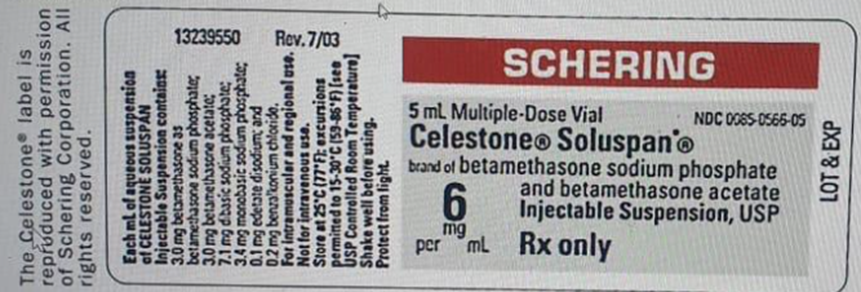Calculate the dosage using the label below. Round to the nearest tenth place. Order: Celestone, Soluspan (betamethasone) 12 mg IM q24 hr. for 2 doses. Available

0.5 mL sub-cut
1 mL Stat
4 mL IV
2 mL IM
The Correct Answer is D
Rationale:
Ordered Dose:
The prescription is for 12 mg of Celestone Soluspan (betamethasone) IM every 24 hours for 2 doses.
Available Dose (from label): The vial contains 6 mg/mL.
Dosage Calculation: Using the formula:
Volume to administer (mL) = Available concentration (mg/mL) / Ordered dose (mg)
Volume to administer = 12mg / 6mg/mL = 2 mL
Administration Route:
The order specifies IM (intramuscular) administration, aligning with the label instructions.
Thus, 2 mL IM is the correct dosage to administer.
Nursing Test Bank
Naxlex Comprehensive Predictor Exams
Related Questions
Correct Answer is D
Explanation
A) Distribution:. Distribution refers to the process by which a drug is transported throughout the body after it is absorbed into the bloodstream. It involves the movement of the drug to various tissues and organs, where it can exert its effects. Factors such as blood flow, tissue permeability, and protein binding affect distribution.
B) Metabolism:
Metabolism refers to the biochemical process by which the body breaks down drugs into metabolites, usually in the liver. Metabolism can transform drugs into more easily excreted forms and sometimes alters the drug’s activity. It is essential for drug clearance and can affect drug efficacy and toxicity.
C) Absorption:
Absorption is the first step in pharmacokinetics, where the drug enters the bloodstream after being administered. It occurs primarily in the gastrointestinal (GI) tract for oral medications but can also happen in other routes like subcutaneous or intramuscular injections. The rate and extent of absorption are influenced by factors such as drug formulation, route of administration, and presence of food.
D) Synthesis:
Synthesis refers to the process of creating substances, such as drugs or other compounds, typically within the body or in a laboratory setting. While drug synthesis is crucial in drug development, it is not a step involved in the movement or processing of drugs within the body (which is what pharmacokinetics describes). Pharmacokinetics focuses on how the body handles drugs, not how they are created.
Correct Answer is A
Explanation
Given:
Ordered dose of Dopamine: 3 mcg/kg/min
Child's weight: 41.8 lbs
Concentration of Dopamine: 400 mg in 250 mL D5W
Step 1: Convert child's weight from pounds to kilograms:
1 pound (lb) = 0.453592 kilograms (kg)
Child's weight in kg = 41.8 lbs x 0.453592 kg/lb = 18.935 kg
Step 2: Calculate the total dose of Dopamine in mcg/min:
Total dose (mcg/min) = Ordered dose (mcg/kg/min) x Child's weight (kg)
Total dose (mcg/min) = 3 mcg/kg/min x 18.935 kg
Total dose (mcg/min) = 56.805 mcg/min
Step 3: Convert mcg to mg:
Total dose (mg/min) = Total dose (mcg/min) / 1000 mcg/mg
Total dose (mg/min) = 56.805 mcg/min / 1000 mcg/mg
Total dose (mg/min) = 0.056805 mg/min
Step 4: Calculate the total dose in mg/hr:
Total dose (mg/hr) = Total dose (mg/min) x 60 min/hr
Total dose (mg/hr) = 0.056805 mg/min x 60 min/hr
Total dose (mg/hr) = 3.4083 mg/hr
Step 5: Calculate the infusion rate in mL/hr:
Infusion rate (mL/hr) = Total dose (mg/hr) / Concentration (mg/mL)
Infusion rate (mL/hr) = 3.4083 mg/hr / (400 mg/250 mL)
Infusion rate (mL/hr) = 3.4083 mg/hr x (250 mL/400 mg)
Infusion rate (mL/hr) = 2.1301875 mL/hr
Step 6: Round to the nearest tenth:
Infusion rate (mL/hr) ≈ 2.1 mL/hr
Whether you are a student looking to ace your exams or a practicing nurse seeking to enhance your expertise , our nursing education contents will empower you with the confidence and competence to make a difference in the lives of patients and become a respected leader in the healthcare field.
Visit Naxlex, invest in your future and unlock endless possibilities with our unparalleled nursing education contents today
Report Wrong Answer on the Current Question
Do you disagree with the answer? If yes, what is your expected answer? Explain.
Kindly be descriptive with the issue you are facing.
